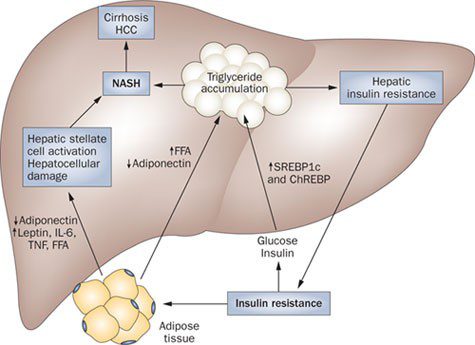
- By: admin
- August 22, 2024
Type 2 Diabetes and Fatty Liver Disease
Diabetes reversal center in Trivandrum | Type 2 diabetes and fatty liver disease, particularly non-alcoholic fatty liver disease (NAFLD), are closely linked conditions that often occur together and share common risk factors. Here’s how they are related:
Indications
- Fatigue: Feeling unusually tired or fatigued is a common symptom of fatty liver disease. This fatigue can be persistent and may not improve even with adequate rest.
- Abdominal discomfort: Some individuals with fatty liver disease may experience discomfort or pain in the upper right abdomen, where the liver is located. This discomfort can range from mild to moderate and may come and go.
- Enlarged liver: In more advanced stages of fatty liver disease, the liver may become enlarged. This enlargement can sometimes be felt as a firm, irregular mass in the upper right abdomen during a physical examination.
- Elevated liver enzymes: Blood tests may reveal elevated levels of liver enzymes, such as alanine aminotransferase (ALT) and aspartate aminotransferase (AST). While elevated liver enzymes can indicate liver damage, they can also be caused by other conditions, so further evaluation is necessary.
- Unexplained weight loss: While obesity is a common risk factor for fatty liver disease, some individuals with the condition may experience unexplained weight loss, particularly if the disease has progressed to more severe stages.
- Insulin Resistance:
- Both type 2 diabetes and NAFLD are strongly associated with insulin resistance, a condition in which the body’s cells become less responsive to the effects of insulin.
- Insulin resistance leads to elevated levels of insulin in the bloodstream, which promotes the accumulation of fat in the liver (hepatic steatosis) and contributes to the development of type 2 diabetes.
- Obesity and Metabolic Syndrome:
- Obesity and metabolic syndrome, characterized by abdominal obesity, high blood pressure, elevated blood sugar, and abnormal lipid levels, are major risk factors for both type 2 diabetes and NAFLD.
- Excess fat accumulation in the body, particularly around the abdomen (visceral fat), contributes to insulin resistance, inflammation, and liver fat accumulation.
- Shared Lifestyle Factors:
- Sedentary lifestyle, unhealthy dietary habits (such as high consumption of processed foods, sugary beverages, and saturated fats), and excessive calorie intake contribute to the development of both type 2 diabetes and NAFLD.
- These lifestyle factors promote weight gain, insulin resistance, and inflammation, all of which are implicated in the pathogenesis of both conditions.
- Mutual Complications:
- Having both type 2 diabetes and NAFLD increases the risk of developing complications such as cardiovascular disease, kidney disease, and liver fibrosis/cirrhosis.
- Individuals with type 2 diabetes are more likely to have advanced forms of NAFLD, including non-alcoholic steatohepatitis (NASH), which involves liver inflammation and can progress to fibrosis and cirrhosis.
5 tips to Prevent Fatty Liver & Cirrhosis
Preventing fatty liver, particularly non-alcoholic fatty liver disease (NAFLD), involves adopting healthy lifestyle habits that promote liver health and reduce the risk of excessive fat accumulation in the liver. Here are five tips to help prevent fatty liver:
- Maintain a Healthy Weight:
- Obesity is a significant risk factor for NAFLD. Aim to achieve and maintain a healthy weight through a balanced diet and regular physical activity.
- Focus on consuming a diet rich in fruits, vegetables, whole grains, lean proteins, and healthy fats, while minimizing intake of processed foods, sugary beverages, and foods high in saturated and trans fats.
- Weight loss through diet and exercise is particularly beneficial for improving insulin sensitivity, reducing liver fat accumulation, and managing blood sugar levels.
- Regular Exercise:
- Engage in regular physical activity, such as brisk walking, jogging, cycling, swimming, or any other aerobic exercise, for at least 30 minutes most days of the week.
- Exercise helps reduce liver fat by improving insulin sensitivity, promoting weight loss, and reducing inflammation in the body.
- Healthy Eating Habits:
- Avoid excessive consumption of high-calorie, high-sugar, and high-fat foods that can contribute to weight gain and liver fat accumulation.
- Practice portion control and mindful eating to prevent overeating and promote better digestion and nutrient absorption.
- Limit alcohol consumption:
- Alcohol consumption is a common cause of liver damage and fatty liver disease.
- If you have risk factors for liver disease or existing liver conditions, it may be advisable to avoid alcohol altogether.
- Monitor and manage medical conditions:
- Manage underlying medical conditions that increase the risk of fatty liver disease, such as obesity, type 2 diabetes, high blood pressure, high cholesterol, and metabolic syndrome.
In addition to these tips, it’s essential to enroll in a Reversal Program and maintain regular communication with your healthcare provider, who can provide personalized guidance, screenings, and interventions based on your individual health status and risk factors. Early detection and intervention are key to preventing or managing fatty liver disease effectively.
Thankyou
Dr Arun Vasudevan
Founder director IDRP
BHMS,MBS (UK), D.Acu,
IDRP, TKD Road, Muttada PO, Trivandrum.
Follow us on: https://www.facebook.com/drarunvs
Instagram: https://www.instagram.com/drarunvs/
Tags: accupressure, best treatment for diabetes, depression, diabetic reversal, heart attack, idrp
